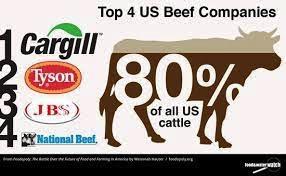|
 The North American Meat Institute (NAMI) representing packers ctiticized the Congressional action on the basis that business information would be disclosed to the USDA with the likelyhood of subsequent publication. Julie Anna Potts, CEO of NAMI, stated “Congress and the Administration say they value transparency in the beef and cattle market, yet they bury this rider without debate in a giant spending bill and direct USDA to create a pilot program without any feedback from beef companies or cattle producers.” The NAMI maintains that there is adequate price discovery under the Livestock Mandatory Reporting Act. NAMI believes that cattle producers have access to regular AMS publications covering time periods, regions, and actual price data, since packers are obliged to report all beef transactions daily through the Box Beef Report. This is posted twice daily on the USDA DataMart website. The North American Meat Institute (NAMI) representing packers ctiticized the Congressional action on the basis that business information would be disclosed to the USDA with the likelyhood of subsequent publication. Julie Anna Potts, CEO of NAMI, stated “Congress and the Administration say they value transparency in the beef and cattle market, yet they bury this rider without debate in a giant spending bill and direct USDA to create a pilot program without any feedback from beef companies or cattle producers.” The NAMI maintains that there is adequate price discovery under the Livestock Mandatory Reporting Act. NAMI believes that cattle producers have access to regular AMS publications covering time periods, regions, and actual price data, since packers are obliged to report all beef transactions daily through the Box Beef Report. This is posted twice daily on the USDA DataMart website.
In contrast, the broiler industry is integrated and despite consolidation, there are in excess of 50 companies participating in production with more than 170 processing plants in operation. Payment to contract growers and egg producers is subject to the restraints of regulations framed in terms of the Packers and Stockyards Act and contract terms between integrators and growers have received increased scrutiny under the current Administration with initial concerns over duration of contracts and the tournanment system.
 At this time it does not seem likely that additional regulations or constraints will be imposed on the broiler industry. An outstanding issue is the status of the proposed acquisition of Sanderson Farms by a consortium of Continental Grain Company and Cargill Inc. that would create a larger version of Wayne Farms, but would not alter the relative position among the top-five Company broiler producers. At this time it does not seem likely that additional regulations or constraints will be imposed on the broiler industry. An outstanding issue is the status of the proposed acquisition of Sanderson Farms by a consortium of Continental Grain Company and Cargill Inc. that would create a larger version of Wayne Farms, but would not alter the relative position among the top-five Company broiler producers.
|